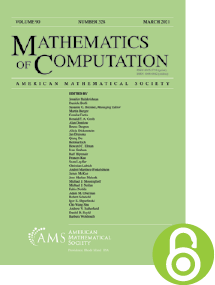New techniques for bounds on the total number of prime factors of an odd perfect number
HTML articles powered by AMS MathViewer
- by Kevin G. Hare PDF
- Math. Comp. 76 (2007), 2241-2248
Abstract:
Let $\sigma (n)$ denote the sum of the positive divisors of $n$. We say that $n$ is perfect if $\sigma (n) = 2 n$. Currently there are no known odd perfect numbers. It is known that if an odd perfect number exists, then it must be of the form $N = p^\alpha \prod _{j=1}^k q_j^{2 \beta _j}$, where $p, q_1, \cdots , q_k$ are distinct primes and $p \equiv \alpha \equiv 1 \pmod {4}$. Define the total number of prime factors of $N$ as $\Omega (N) := \alpha + 2 \sum _{j=1}^k \beta _j$. Sayers showed that $\Omega (N) \geq 29$. This was later extended by Iannucci and Sorli to show that $\Omega (N) \geq 37$. This was extended by the author to show that $\Omega (N) \geq 47$. Using an idea of Carl Pomerance this paper extends these results. The current new bound is $\Omega (N) \geq 75$.References
- R. P. Brent, G. L. Cohen, and H. J. J. te Riele, Improved techniques for lower bounds for odd perfect numbers, Math. Comp. 57 (1991), no. 196, 857–868. MR 1094940, DOI 10.1090/S0025-5718-1991-1094940-3
- E. Z. Chein, An odd perfect number has at least 8 prime factors, Ph.D. thesis, Pennsylvania State University, 1979.
- Graeme L. Cohen, Generalised quasiperfect numbers, Ph.D. thesis, University of New South Wales, 1982.
- Graeme L. Cohen and Ronald M. Sorli, On the number of distinct prime factors of an odd perfect number, J. Discrete Algorithms 1 (2003), no. 1, 21–35. Combinatorial algorithms. MR 2016472, DOI 10.1016/S1570-8667(03)00004-2
- Peter Hagis Jr., Outline of a proof that every odd perfect number has at least eight prime factors, Math. Comp. 35 (1980), no. 151, 1027–1032. MR 572873, DOI 10.1090/S0025-5718-1980-0572873-9
- Peter Hagis Jr., Sketch of a proof that an odd perfect number relatively prime to $3$ has at least eleven prime factors, Math. Comp. 40 (1983), no. 161, 399–404. MR 679455, DOI 10.1090/S0025-5718-1983-0679455-1
- Kevin G. Hare, More on the total number of prime factors of an odd perfect number, Math. Comp. 74 (2005), no. 250, 1003–1008. MR 2114661, DOI 10.1090/S0025-5718-04-01683-7
- D. E. Iannucci and R. M. Sorli, On the total number of prime factors of an odd perfect number, Math. Comp. 72 (2003), no. 244, 2077–2084. MR 1986824, DOI 10.1090/S0025-5718-03-01522-9
- Masao Kishore, Odd perfect numbers not divisible by $3$. II, Math. Comp. 40 (1983), no. 161, 405–411. MR 679456, DOI 10.1090/S0025-5718-1983-0679456-3
- Pace P. Nielsen, Odd perfect numbers have at least nine distinct factors, Math. Comp. (to appear).
- Karl K. Norton, Remarks on the number of factors of an odd perfect number, Acta Arith. 6 (1960/61), 365–374. MR 147434, DOI 10.4064/aa-6-4-365-374
- Carl Pomerance, Odd perfect numbers are divisible by at least seven distinct primes, Acta Arith. 25 (1973/74), 265–300. MR 340169, DOI 10.4064/aa-25-3-265-300
- M. Sayers, An improved lower bound for the total number of prime factors of an odd perfect number, Master’s thesis, New South Wales Institute of Technology, 1986.
Additional Information
- Kevin G. Hare
- Affiliation: Department of Pure Mathematics, University of Waterloo, Waterloo, Ontario, Canada, N2L 3G1
- Email: kghare@math.uwaterloo.ca
- Received by editor(s): July 25, 2005
- Received by editor(s) in revised form: October 10, 2005
- Published electronically: May 30, 2007
- Additional Notes: The research of the author was supported in part by NSERC of Canada.
- © Copyright 2007 by the author
- Journal: Math. Comp. 76 (2007), 2241-2248
- MSC (2000): Primary 11A25, 11Y70
- DOI: https://doi.org/10.1090/S0025-5718-07-02033-9
- MathSciNet review: 2336293


